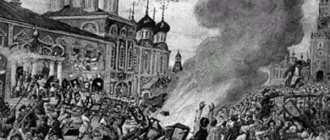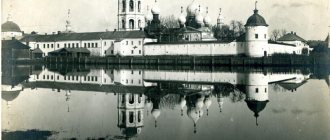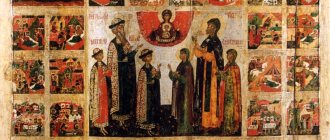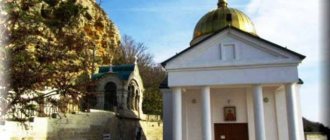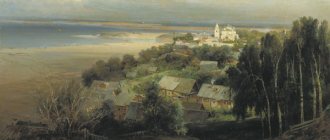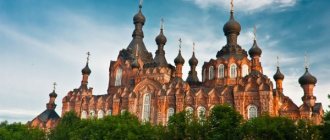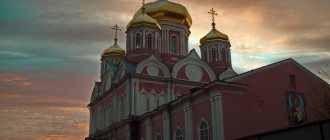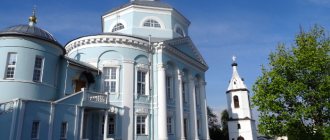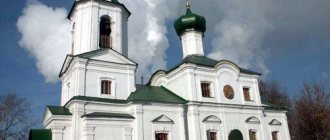Sretensky Monastery is the oldest Orthodox monastery, located almost in the very center of Moscow.
What makes this monastery attractive to pilgrims is not only the incredible beauty of the church chants (and the choir of the Sretensky Monastery is considered the main one in the Russian Orthodox Church), but also the miraculous shrines stored in the monastery’s churches.
Address: Moscow, st. Bolshaya Lubyanka, 19
Opening hours: as a rule, the Divine Liturgy is celebrated at the Sretensky Monastery every day at 8.00, and the Evening Service at 18.00. In any case, before visiting the monastery, check the schedule of services on the official website, as numerous Orthodox holidays make their own adjustments.
How to get there by car
Sretensky Monastery (Moscow) is located in the historical district of the capital. Muscovites can provide orientation to city guests and show them directions. Believers and tourists, whose starting point begins at the foot of Red Square, are advised to head to the area of Sretensky Boulevard along Bolshaya Lubyanka.
The holy place will be located on the left, immediately after the first intersection, where the passage runs through Sretensky Lane. There is also a white stone fence and a sign that will take you a few minutes to the monastery.
If the road by personal transport starts from the northern side of the city, then you need to follow Yaroslavskoye Highway and Mira Street until Red Square comes into view. On the Garden Ring, the driver is advised not to miss the left turn and, keeping to the inner ring, continue driving to Akademik Sakharov.
When the car follows the avenue, turn right and continue driving. Next, you will see a sign for the Turgenevskaya metro station, at which you should turn left and continue along the boulevard ring to Myasnitskaya Street. Near the Kalyagin Theater you need to keep the road going to the right and drive a little along Bobrov Lane.
On the next lane - Milyutinsky - turn again, only to the left and move all the way to Sretensky Lane until a white stone wall appears. Here you can, if possible, leave your car and start exploring the monastery.
Relics of Hilarion
Particularly revered in the Sretensky Monastery are the relics of the Hieromartyr Hilarion.
Hilarion was born in 1886 into the family of a clergyman in a village located in the Tula province. All his life he studied diligently, was engaged in scientific works, and became a monk in 1913.
After the revolution, Hilarion did not reject his faith and continued to conduct services and work on historical works. In 1921, he was arrested, the reason for which was the organization of a crowded prayer service within the walls of the Sretensky monastery.
After spending a short time in prison, the archbishop was released and again taken into custody two years later. After several years on Solovki, Illarion was sent to Kazakhstan. On the way, he was robbed, and he, suffering from typhus, ended up in Leningrad.
In December 1929, the 43-year-old archbishop died in delirium. Dying, he insisted that he had found the long-awaited freedom. During the funeral service, it was impossible to recognize the former Hilarion in the exhausted old man.
A year before the beginning of the 21st century, the archbishop was canonized and his holy remains were transferred to the Sretenskaya monastery. Memorial Day – December 15th.
How to get there by public transport
The Sretensky Monastery is located, like many historical sights of Moscow, within walking distance from the entrance to the metro stations:
- Sukharevskaya.
- Chistye Prudy.
- Lubyanka.
- Turgenevskaya.
If we consider stations 2 and 4 as the starting point, then it is necessary to move along the transition to Academician Sakharov Avenue. The journey will take no more than 5 minutes along the sidewalk; at Bolshaya Lubyanka you need to turn left, after which the Sretensky Gate opens to your horizons. From the 3rd station on the list above, it takes about 7-8 minutes to walk. It is recommended to walk forward along Lubyanka towards the Garden Ring.
If you get off the train at Sukharevskaya, then from the subway you should follow the signs towards the exit to Sretenka Street. On the street you need to choose the path towards Red Square, which will pass along Mira Avenue. From the first departure point the journey will take about 15 minutes. A metro ticket will cost 50 rubles.
But you can get to the beautiful monastery not only on foot. Bus No. M9 passes by the monastery. Its route runs from the Kitay-Gorod subway stop to Vladykino. Non-local residents should know that it will not be possible to return by this transport, due to the fact that its route does not pass through the monastery.
The same situation is with bus No. N6, which on the way from Kitay-Gorod to Ostashkovskaya Street crosses Lubyanka, which allows you to quickly get to the monastery, but the bus goes back along a different road.
In this case, you can drive up to the Sukharevskaya stop, from where you can easily reach the monastery on foot. You can get to the Turgenevskaya metro station, which is located near the men’s monastery, from the Sokolniki metro station, and then by public transport No. 122.
When exiting the subway at the “Lubyanka” or “Kuznetsky Most” stop, you can get to the temple on the following buses:
- M10;
- 38;
- M3;
- M7;
- M2;
- T25;
- 144;
- M8;
- M5;
- 101;
- 904;
- 158.
The price of a travel ticket varies within 50 rubles.
The historically important place can be reached by minibus No. 325, which costs 35 rubles. The route runs from the Semenovskaya metro station, exit at Lubyanskaya Square.
How to easily and quickly get to the Sretensky Monastery in Moscow
The easiest and most convenient way to get there is by metro, to Sukharevskaya station, orange line. Exit the last car from the center, turn right, follow the sign to Sretenka Street. We went outside and looked around.
On one side is the Garden Ring and on the other is the Church of the Holy Trinity in Listy. You move towards the temple, along Sretenka. Walk past the church, it is on your right. Walk about eight hundred meters to a large intersection, to a traffic light. The intersection of the Boulevard Ring and st. Sretenka.
Sretensky Monastery
At the intersection on the right there will be a small Assumption Church, cross the Boulevard Ring and you are almost there. Another couple of tens of meters and on the right is the entrance to the monastery, turning your head to the right, you will see the temple of the Church of the Resurrection of Christ, New Martyrs and Confessors of Russia. You're at the place.
By car you enter from the inner Garden Ring, on Sukharevskaya Square you change lanes to turn right into the alternate and turn along it to Ananyevsky Lane, on weekdays park in a free space, all parking spaces are paid for 150 rubles per hour, on weekdays almost all spaces are occupied.
Continue on foot to Rozhdestvensky Boulevard, then turn right and straight until you reach the Sretensky Monastery. To avoid worrying about money leaking out, leave the car in a residential area where it is free and take the metro or taxi. Spend time in devotional reflection and prayer.
Schedule of Divine Services on weekdays:
- Divine Liturgy, confession 8-00
- All-night vigil 18-00
On Sundays and holidays:
- Early Divine Liturgy, confession 7-00
- Late Divine Liturgy 10-00
- Prayer service with akathist to the holy martyr 13-00
- Evening service 18-00
History of the monastery
Sretensky Monastery (Moscow) was mentioned in the chronicles of 1395, then a religious procession led by Cyprian (Metropolitan) took place, during which the image of the Mother of God of the Vladimir Icon appeared to them. Based on historical events, it was after meeting with the miraculous image that Timur-Tamerlane, walking towards Moscow, turned south, and the city was saved.
Initially, a wooden building was erected, near which, soon, a monastery was built. Since those very events, according to tradition, every year on August 26, a religious procession is organized from the Assumption Cathedral to the monastery with the Vladimir Icon.
Recently, there has been debate about the original location of the holy site. Sukhman, in the mid-80s of the last century, suggested that the monastery previously stood near the Nikolsky Gate of Kitay-Gorod, and was later moved in connection with the construction of the Kitay-Gorod wall. Now, thanks to the Typographical Chronicle, this information has been confirmed.
The monastery was considered the starting point of many crusades, in which the metropolitan and the prince took part. The year 1480 became the founder of the tradition of a procession in honor of liberation from the Crimean invasion.
The Time of Troubles began with the occupation of the monastery by invaders: Russian militias settled within the walls, who fought for Minin and Pozharsky, the latter was treated within the walls of the monastery when he was wounded in 1611. Towards the end of the 17th century, the monastery was moved to its current location, and a chapel was erected in its place, which was transformed into the Vladimir Church.
| Time frame | Historical events of the monastery |
| Second half of the 17th - early 18th centuries | The sovereign's family always made generous donations; Mikhail Romanov gave a decree on the construction of buildings for the rector's and cell purposes. The reign of Feodor Alekseevich had a positive impact on the temple; it was in the prime of its activity. In 1706, part of the remains of Mary of Egypt were transported here. The 18th century was a time of decline for the monastery; at the end of the 30s, a fire destroyed some buildings. In the mid-60s, Empress Catherine 2 carried out the secularization of church areas, after which the monastery received the status of a supernumerary and had to support itself. |
| 19th century | The monastery took the path of revival, Metropolitan Platon and St. Philaret helped in this. Within the walls of the monastery, even during the war with the French, the words of prayer did not subside. During the Battle of Borodino, believers came out of the temple with a procession of the cross that moved towards the Arbat Gate, past wounded soldiers. The priests, carrying miraculous icons, sprinkled holy water on the soldiers. It is believed that the religious procession and prayers influenced the psychological state of Napoleon, who in the midst of the battle was overshadowed and often changed his orders. After the battle, the monastery housed the wounded soldiers within its walls, and the clergy helped bury the dead in the church cemetery. The notes of the Russian soldier mentioned events reflecting the heroic loyalty of the priest of the Sretensky Monastery. The story goes that the French soldiers gave the order, by decree of Bonaparte, that the clergyman should pray for the French emperor under the threat of the gallows, but the brave priest replied that he had sworn allegiance to the Russian Tsar and would faithfully pray for Alexander even under the hand of the executioner. The French found this answer worthy of respect and left the believer to pray and do his duty. The flames of the fire that burned half of Moscow did not touch the walls of the monastery, and thanks to the ringing of the bells it became famous among residents and guests of the capital. An educational institution for parishioners and a hotel-type complex were opened in the monastery. |
| Soviet Union period | The year 17 is remembered by believers as the beginning of the expulsion of monks and the seizure of cells. In the early 20s of the last century, all icons were confiscated, supposedly to help the poor from the Volga region, as well as altar crosses and other liturgical objects, and Hilarion was expelled. For a year, the schismatics felt themselves masters here with the self-called “Metropolitan” Antonin. In 1923, Hilarion was returned from exile, and on July 5 he consecrated the monastery’s cathedral, which had been desecrated by the Renovationists. Already in November he was arrested again and sent into exile. He left Boris Rukin as his successor. In 1926, the monastery was closed, and 2 years later they began to destroy many of the buildings at the temple. In 1928, plans were made to demolish the building to expand street traffic. As a result, the Church of Mary of Egypt was destroyed and the icons were distributed to museums. Those buildings that remained intact served as a dormitory for NKVD officers for a short period of time. Executions were carried out on the territory of the monastery. In the middle of the last century, a high school was built on the land of the church cemetery. Later, the façade and interior were restored. |
| Modernity | In 1991, the building was transferred to the use of the Orthodox Church and a parish was organized headed by Georgy Kochetkov. Two years later, the courtyard of the Pskov-Pechersky Monastery was opened. In 1996, the temple was renamed a stauropegic monastery, and Tikhon became the vicar. Thanks to the allocated funds from Sergei Pugachev, the monastery began to develop: a new fence was built, a bell tower was erected, and restoration work began to be organized. In the last year of the outgoing century, a higher monastic school opened its doors, which, after 2 years, was given the status of a theological seminary. |
Monastery buildings
Cathedral Church
The five-domed cathedral church of the monastery (the only one to survive in the 20th century) was built in 1679 at the expense of Tsar Feodor Alekseevich. The style of the cathedral is Moscow-Yaroslavl, with characteristic features of church architecture of the era of Patriarch Nikon. The temple has a square shape, three aisles, a three-part apse, and two pillars. From the outside, the upper part of each wall of the temple is decorated with three arches; in the gaps of the central arches there are large icons. The cathedral is crowned with five domes, the drum of the central dome is light, the rest have decorative windows. The temple is adjacent to two chapels and a gallery with a belfry. The southern chapel of the Nativity of John the Baptist was built in 1706; The northern chapel of St. Mary of Egypt was built in 2000 and consecrated in 2008. The modern iconostasis of the cathedral - five-tiered (contains local, deesis, festive, prophetic and forefathers rows), tyablo - was created in 1995, on the 600th anniversary of the transfer of the Vladimir Icon from Vladimir to Moscow. in the style of the XV-XVI centuries.
In 2008, a gallery with a belfry was added to the cathedral. Also, 2 altars were consecrated - in the northern part in honor of Mary of Egypt, and in the crypt of the cathedral there is an Angel chapel.
In the lower floor of the cathedral there is a crypt with a chapel of the Resurrection of Christ (in the image of the Church of the Holy Sepulcher in Jerusalem; consecrated in 2008). The decoration of the crypt is reminiscent of ancient Christian catacomb churches.
Other buildings
Until 2010, school No. 1216 with in-depth study of the French language was located on the territory of the Sretensky Monastery. Beginning in 2004, the Russian Orthodox Church sought to evict the educational institution under the pretext that the school building was located on the site of a graveyard where soldiers who died during the Patriotic War of 1812 were buried. In 2010, the school building was transferred to the monastery; restored in 2012.
In 2008–2012, the monastery was given premises on Rozhdestvensky Boulevard, which had previously been occupied by various organizations, including the All-Russian Musical Society and a hotel.
Construction of a new temple
On the territory of the monastery it is planned to erect a “temple on blood” in honor of the new martyrs and confessors of Russia: in the spring of 2011, Patriarch Kirill spoke in favor of perpetuating on the territory of the monastery the memory of those who died for their faith during the years of persecution of the Church. An open competition held in October-December 2012, to which 48 projects were submitted, was won by Dmitry Smirnov’s workshop. The consecration of the temple is planned for 2021. A preliminary design by D. Smirnov and Y. Cooper, according to which the new building will exceed the height of the existing monastery church by about 10 meters, and its area will be more than 10 thousand square meters. m. was approved in December 2012. According to the project documentation, the main area of the building will be allocated to the museum and various service and technical premises (treasury, economic department, meeting room, archive and warehouse of anti-alcohol products, sewing shop and others), and the area of the temple itself will occupy only about 5% of the new building ; The underground space will accommodate parking for 90 cars. Archimandrite Tikhon claims that at least 50% of the areas under construction will be used for the upper and lower churches and its services, sacristies, as well as stairs, escape routes and corridors.
In the fall of 2013, plans for the project drew criticism from historic preservationists, members of the architectural community and some local residents. Representatives of the All-Russian Society for the Protection of Historical and Cultural Monuments spoke out against the demolition of the building and the construction of a new temple, who call the project a “tacky remake” and believe that the construction violates the “principles of preserving historical heritage and respect for the spiritual and material culture of Russia”; they also point out that during the new construction, a valuable archaeological layer that has been preserved since the 14th century will also be damaged. The “Arkhnadzor” movement draws attention to the fact that the construction of new buildings here is directly contrary to the law, since in 2010 the territory of the monastery was recognized as a protected zone of a cultural heritage site. Urban defender Konstantin Mikhailov noted that the 40-meter building will become the new high-rise dominant of the area and will destroy the historical appearance of Rozhdestvensky Boulevard.
In order to change the boundaries of the protected zone of the monument, the head of the Moscow Heritage Committee, Alexander Kibovsky, sent a corresponding letter to the Minister of Culture Vladimir Medinsky. In November 2013, the Moscow Heritage Committee approved the demolition of six monastery buildings to make way for construction. In the same month, five urban protection and architectural organizations sent a joint appeal to Russian President Vladimir Putin and Patriarch Kirill with a request to prevent the demolition of historical buildings and to conduct a full public and expert discussion of the new construction project on the territory of the monastery. On December 19, the historical buildings were demolished.
Architect and external decoration of the monastery
Sretensky Monastery (Moscow) was designed and built in the Yaroslavl style with Moscow elements, where the features of church architecture from the period of Patriarch Nikon’s life are visible. The cathedral with 5 chapters was built in the late 70s of the 17th century with funds allocated by the tsar.
The structure is distinguished by its 3-aisles, square shape and the presence of three-part projections. In the outer walls there are 3 arches, inside of which are the faces of saints. The building is decorated with 5 domes, the main one being optical. The building is adjacent to an extension with a bell installation and 2 limits: southern (John the Baptist) and northern (Mary of Egypt).
Lower, winter Church of the Sretensky Cathedral
The Lower Temple of the Presentation Cathedral is dedicated to John the Baptist and the twelve Apostles. It is like a cave, you can clearly see the glare of the painting on the ceiling, below there is an authentic mosaic and a baptistery, a font in the shape of a ship, decorated with Italian smalt, of which there are 126 shades.
Moscow Sretensky Monastery
Ancient symbols, emblems of the Evangelists, the letters alpha and omega, the beginning and end of everything, the monogram of the name of Christ the Savior were used.
Since the Sretensky Monastery is the smallest of the Moscow monasteries in terms of territory, the architects were asked to provide additional premises for technical services, recreation and studies. There are two underground tiers under the Cathedral.
On the minus second floor there are storage rooms, workshops, laundries, on the minus first floor there is a meeting room with semicircular rows of chairs, a nearby lecture hall and Sunday school classes.
Sretensky Seminary
The first schools in Rus' were at monasteries; today, seminaries are located in monasteries. Sretensky Theological Seminary is rated very highly.
The seminary building was built in the fifties of the last century as a secondary school with in-depth study of the French language, a standard project.
In the tenth years of the 21st century, the building was rebuilt as a Seminary, an attic floor was added, the windows were decorated with large frames, and the walls were enlivened with paintings.
Service at Sretensky Monastery
Sretenskaya Seminary offers a four-year bachelor's degree and two master's degrees. It has a magnificent library with a reading room with huge ceilings. Those who like to study with paper media come here.
All seminary books are digitized and students can read them on their gadgets. Books raised the monastery. In the nineties, after seventy years of atheist rule, there was no spiritual literature or liturgical books.
The monastery took out a loan and began publishing books; after several printings, funds appeared for repairs, construction, and paying employees. The most famous publication of the Sretensky Publishing House is a book by the abbot of the monastery, Father Tikhon.
“Unholy Saints” went through seventeen editions, with a total circulation of over two and a half million copies.
Sretensky schedule
Design of Seminary classes
All classes in the seminary are equally different, thematic with the names Byzantium, Antiquity, Holy Land, and everywhere have their own stylized furniture. There are thematic paintings on the ceilings and teaching materials on the walls.
Each time a student finds himself in a different atmosphere, even if he gets bored in class, he can usefully look around. They say they turn on the front camera and look at what’s behind them.
The educational process, as in other universities, rarely requires a teacher to take paper notes and is not allowed into classes with gadgets. Basically, they record their lectures themselves and post them on the Internet for free access by students.
The monasteries gave Rus' icon painters Cherny, Dionysius, Rublev; the Sretensky Monastery does not have its own icon-painting workshop, but a school of icon painting has appeared.
Divine services in the Sretensky Monastery
As has already been said, the invited painters painted on a wavy background; for the first time such a technique was tested in the seminary lobby.
Above the stairs there is a large painting based on the book of the governor of the monastery “Unholy Saints”, it depicts the heroes of the book, priests, monks of the Pskov-Pechersk monastery, the family of the last Russian Emperor and two writers, Dostoevsky and Gogol.
Architectural ensemble of the monastery
The iconostasis of the face of the benefactors of the royal dynasty was installed thanks to the decree of Empress Agafya Grushetskaya and her husband. Not far from the entrance doors there were images of Saints Agathia and Theodore. At the beginning of the 18th century, the chapel of John the Baptist was added to the building.
A year later (1707) the monastery was painted at the request of S.F. Griboyedov. The frescoes that are located inside the monastery are one of a kind and belong to the creation of fine ancient art. A little later, a chapel was built in honor of the Presentation of the Lord.
In 1761, the Shumaev cross was installed, which is an 8-meter installation with an iconographic plot, which was created by the merchant Shumaev. The worship cross, reminiscent of the victims of the atheistic dictatorship, was installed in 1995.
Interior decoration
The restoration of the cathedral took place over 4 years until 1962. The restoration work affected only the facade of the building; the interior decoration and artistic painting remained in unsatisfactory condition.
The iconostasis has five tiers:
- Deesis;
- prophetic;
- festive;
- local;
- forefatherly.
Iconostasis in the Sretensky Monastery (Moscow)
The Tyablo iconostasis was created for the 600th anniversary of the transfer of the Vladimir Icon. At the lower level of the temple there is a crypt, which is a mosaic of light marble stone with engraved attributes, with a chapel of the Resurrection of Christ. It contains a copy of the Shroud of Turin, which was consecrated by Patriarch Alexy 2.
Educational courses of the Sretensky Monastery
Nowadays, educational courses are held for Orthodox laity in the Moscow Sretensky Monastery. In 2021, meetings are dedicated to family.
Speeches are given by clergy, psychologists and teachers of the Orthodox faith. The gathering place is the lower church of the new cathedral. The event starts at noon. To register for courses, you must fill out an online form.
Shrines and relics of the monastery
Sretensky Monastery (Moscow) keeps within its walls a copy of the Shroud of Turin, made in a size corresponding to the original.
The abbots carefully monitor the safety of other important shrines, such as particles of the remains of holy people:
- Illarion (transported from St. Petersburg in 1999);
- Nicholas the Wonderworker;
- Basil the Great;
- Mary of Egypt;
- John Chrysostom;
- Sarovsky Seraphim.
The depicted faces of the Vladimir and Iveron Mother of God were kept in the building for some time (until 1813); the speedy completion of the restoration work carried out in the Assumption Cathedral contributed to their return to their original location.
Shrines
The Cathedral of the Presentation of the Vladimir Icon is still active today; its construction was completed in 1677.
In the Sretensky complex there are two inactive churches: St. Nicholas and Mary of Egypt, rebuilt in 1835.
The following are considered miraculous icons:
- image of the Vladimir Mother of God;
- the face of the hermit monk Seraphim of Sarov and his relics.
Within the walls of the Orthodox monastery are the remains of St. Hilarion (of the Trinity), an x-ray of the famous Turin veil depicting the body of Christ, a small part of the relics of St. Mary of Egypt and particles of the relics of Basil the Great, John Chrysostom and other Orthodox saints.
Mentors
At the beginning of the 17th century, Metropolitan Kirill of Pereslavl and Rostov stood at the head of the priesthood. After the revolution of 17, Patriarch Tikhon held services here. Hilarion conducted liturgies at the monastery from 1920 to 1923. He was sent into exile twice; he did not return from imprisonment in the Solovetsky camp, where he was sent on October 15, 1923.
The receiver who continued to read prayers at the monastery was Boris Rukin. In the early 90s of the last century, after the building came under the leadership of the Christian Church, a parish was organized, headed by Georgy Kochetkov. After the temple was converted into a monastery in 1996, Tikhon Shevkunov (abbot) was appointed vicar.
Currently, since 2021, Ionanna Ludishchev (hieromonk) has been appointed viceroy.
History of the founding of the stauropegic monastery
The Sretensky Monastery has been mentioned in chronicles since 1397. Its construction marks the victory of Vasily I over Tamerlane’s army. An Orthodox wooden complex was erected near Kitay-Gorod.
The location for the church was not chosen by chance. Back in 1395, here the highest bishop Cyprian met the Vladimir Icon of the Mother of God, taken from Vladimir on the Klyazma River. A solemn prayer service was held on the occasion of the discovery of the icon.
Since the opening of the church, it has been assigned a vital role in the capital's spiritual life.
In the 17th century, the monastery was moved due to the construction of stone walls of Kitay-Gorod.
The first building was a stone chapel. Thanks to abundant contributions from the treasury, the monastery grew and acquired churches and fraternal buildings.
The year 1737 was significant when fire partially destroyed the monastery buildings. And since 1764, the monastery began to decline, declared unemployed and no longer financed from the royal treasury.
In the 19th century, the revival of the monastery began. During the war with Napoleon, daily services were held in the temple. The monks nursed the wounded soldiers, and buried the dead in the monastery cemetery.
The bells of the Sretensky Monastery were heard over long distances, and numerous pilgrims found shelter on the territory.
The children of Orthodox believers were educated in the parish school.
After the revolution of 1917, stagnation again sets in in the history of the monastery. The rector, Bishop Hilarion, is exiled to Solovki, and the monastery is liquidated. The premises begin to be used for economic needs, which leads to neglect and partial destruction.
Restoration of the Sretensky Church began in 1958, and in the 90s the cathedral was returned to believers. The summer of 1996 was the time of restoration of the monastery.
In the last year of the 20th century, a school was opened, which later turned into a theological seminary.
Service schedule, operating hours
Sretensky Monastery (Moscow) receives visitors and parishioners every day from 8 am, at which time the liturgy is celebrated. In the evening there is a service at 18.00. When visiting on your own, it is recommended that you familiarize yourself with the seasonal schedule of prayers on the official website.
Due to the numerous celebrations of Orthodox holidays, the abbots may make temporary adjustments to the operating hours of the monastery. After lunch on Friday, an akathist to the Mother of God is held. On holidays and Sundays, mass takes place at 7 and 10 am under the leadership of Tikhon.
Contact Information
The exact location of the Sretensky Monastery: Moscow, st. Bolshaya Lubyanka, 19, building 1. Exact coordinates: 55°45'56.0″N 37°37'49.0″E.
Contact phone number; 8 (495) 628-78-54
Official website address on the Internet: www.pravoslavie.ru
It is more convenient to get to the monastery by metro, getting off at the Sretenskie Vorota stop. The territory of the Sretenskaya Monastery is a 15-minute walk away.
You should depart from the stations: Turgenevskaya, Sukharevskaya, Kuznetsky Most, Tsvetnoy Boulevard, Chistye Prudy, Lubyanka.
The doors of the monastery are open all days of the week from 6:30 am until the evening.
Description and cost of excursions
The monastery’s pilgrimage service offers tourists excursions, which are conducted as part of an organized group or individually.
Topics offered:
- Secrets of the Shroud of Turin.
- God in the history of Russia and in the life of the monastery.
- Baptismal font.
- Fulfilled and future prophecies of the Holy Scriptures.
- Getting to know the temple.
- Orthodox vocabulary of the English language.
- Saints of the 20th century.
- Hieromartyr Hilarion.
Excursion times on weekdays: 16.00, on Friday and Saturday times may vary: 14.00, 15.00, 16.00. On Sundays, excursions start at 12.30, but, depending on the topic, can be organized at 13.00 or 14.00. Pilgrimage trips to the monastery, with a minimum group of 7 people (family format), cost approximately 300 rubles. per person.
Patronal holidays
| Name (in the name) | Celebration date |
| Vladimir Icon (its transportation) | 08.09 |
| Mary of Egypt | 09 and 14 April |
| Liberation of the capital from Khan Akhmat | 06.07 |
| Nicholas the Wonderworker | 22.05 and 19.12 |
| Saving Moscow from the Tatar invasion (Khan Makhmet-Girey) | 03.06 |
| Hilarion Troitsky | 03.11 |
| Presentation of the Lord | 15.02 |
Interesting facts about the monastery
For 30 years (until the 90s of the last century), the monastery housed an art research and restoration center under the direction of Grabar. The glorification of Hilarion, who was previously the abbot of the monastery, took place only on May 10, 1999.
The building houses numerous literature and houses the publishing house of the Orthodox Church. At the beginning of the 21st century, the website “pravoslavie.ru” was launched, which has been considered the most popular site among believers for more than a decade.
The choir, which can be heard in the monastery, under the direction of Nikon Zhil, has the status of the leading singing group of the Christian Russian church community. The sonorous voices of those singing in the choir can be heard at services, as well as at concerts in Russia and abroad.
Recent history and modern life of the monastery
In January 1991, the preserved building of the Cathedral of the Presentation of the Vladimir Icon of the Mother of God was transferred to the use of the Russian Orthodox Church; Here one of the parishes of the Sretenie brotherhood was created, headed by priest Georgy Kochetkov.
In 1993, the Sretenie brotherhood was transferred to the neighboring Church of the Assumption in Pechatniki (on the Sretensky Gate); In the Sretensky Monastery, a courtyard of the Pskov-Pechersky Monastery was opened. The transfer of the brotherhood was accompanied by excesses: Cossacks participated in its expulsion from the temple, who cordoned off the cathedral and did not allow parishioners there.
In July 1996, by decision of the Synod, the metochion was transformed into the Sretensky stauropegial monastery, the abbot of which was appointed abbot (now Bishop of Yegoryevsk) Tikhon (Shevkunov). The latter often appeared in the press as “Putin’s confessor.”
In memory of all the victims of the atheistic government, a worship cross was erected at the entrance to the monastery in September 1995, consecrated by Patriarch Alexy II.
The monastery began to develop intensively and be built after 1994, largely, according to media reports, at the expense of S. Pugachev, who had a reputation as an entrepreneur close to the Kremlin. The monastery was in conflict with some tenants of neighboring premises. In 1995, a new fence and bell tower were built along Bolshaya Lubyanka in the spirit of 17th-century architecture; these buildings do not reproduce the original forms of monastery buildings.
On May 9-10, 1999, the glorification of the Hieromartyr Hilarion, Bishop of Verei († 1929), who was rector of the monastery in 1923, took place in the monastery cathedral.
In the fall of 1999, classes began at the Sretensky Higher Orthodox Monastic School. By the decision of the Holy Synod of the Russian Orthodox Church on July 17, 2001, the school was given the status of a Theological Seminary, and on December 26, 2002, the Holy Synod renamed the school Sretensky Theological Seminary.
The monastery houses one of the largest publishing houses of the Russian Orthodox Church. In 2000, the online portal Pravoslavie.Ru was created at the Sretensky Monastery, which for many years has maintained its position as the most visited Orthodox website.
The Sretensky Monastery Choir (artistic director, regent - Honored Artist of Russia Nikon Zhila) has the status of the main choir of the Russian Orthodox Church, sings at festive services, and conducts concert activities in Russia and abroad.
Information for pilgrims
The Sretensky Monastery (Moscow) attracts pilgrims with church chants of the famous male choir - the main one in the Russian Church. Many believers strive to touch the miraculous shrines stored there. It organizes both internal group visits to the monastery and outings around Moscow and Russia.
For example, “Moscow Resurrection” is a bus trip for a group of 25 people, the cost for adults is 650 rubles, for schoolchildren – 450 rubles. The pilgrimage tour to the Moscow region “Patron of the Zvenigorod Land – Savva Storozhevsky” is aimed at adults, a ticket for whom will cost 1,700 rubles. per person, with an organized group of at least 25 people.
Article design: Vladimir the Great
